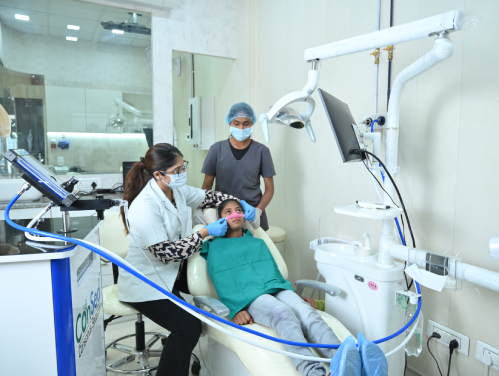
Root Canal Treatment
Our skilled endodontists put your comfort and the outcome of the procedure first when diagnosing and treating complex dental issues. We identify the causes of tooth pain using state-of-the-art imaging and diagnostic technologies, and we only recommend root canal therapy (RCT) when necessary.
- Endodontists identify and resolve problems.
- Make use of sophisticated imaging technologies.
- RCT is advised when it's required.
- Simple process using contemporary methods.
Root Canal Treatment (Endodontic Therapy) Service Overview:
This article describes root canal therapy (RCT) and its various forms, emphasizing that the treatment’s main goal is to preserve and repair badly damaged teeth. The importance of endodontists and the various RCT strategies based on the state of the tooth are emphasized.

Pain Relief
RCT effectively alleviates the severe toothache caused by infected or inflamed dental pulp. Once the damaged tissue is removed, the pain subsides.

Infection Control
The procedure removes infection from the tooth's interior, preventing the spread of bacteria to surrounding teeth or elsewhere in the body.

Tooth Preservation
RCT allows for the preservation of a natural tooth that might otherwise need to be extracted. Retaining a natural tooth is ideal for maintaining proper chewing function and preventing adjacent teeth from shifting.

Aesthetic Restoration
After RCT, the tooth can be restored with a crown or filling, ensuring it looks and functions like a natural tooth.
Our Process:
- Primary Root Canal Treatment: This is the standard RCT performed on a tooth with infected or damaged pulp. The procedure involves removing the pulp, cleaning the canals, and sealing them to prevent reinfection. It is typically done on teeth with a single/multiple roots which have decayed down to the point of no return
- Retreatment (Endodontic Retreatment): In some cases, a previously treated tooth may develop a new infection or fail to heal properly. Retreatment involves reopening the canals, cleaning, and resealing them to address the persistent or recurrent issue.
- Apicoectomy (Surgical Root Canal): When traditional RCT is not sufficient to resolve an infection, an apicoectomy may be performed. In this surgical procedure, the tip of the tooth's root is removed, and the surrounding area is cleaned and sealed.
- Pulpotomy: Pulpotomy is a partial root canal treatment often performed on primary (baby) teeth with infected pulp. It involves removing the infected pulp tissue from the pulp chamber while preserving the healthy pulp in the root canals.
- Internal Bleaching (Non-surgical): Internal bleaching is performed on teeth that have undergone RCT but have discolored over time. A bleaching agent is placed inside the tooth to lighten and improve its appearance.
- Partial RCT (Partial Pulpotomy): Partial RCT is performed when only a portion of the pulp is infected, typically in traumatic injuries. The affected portion is removed, and the remaining healthy pulp is preserved.
- Vital Pulp Therapy (Pulp Capping): Vital pulp therapy is performed when the pulp is injured but still vital (alive). It involves placing a protective material over the exposed pulp to promote healing and preserve the tooth..
- Direct Pulp Capping: In cases of small pulp exposures due to trauma or decay, direct pulp capping is performed. A medicated material is placed directly on the exposed pulp to encourage healing.
- Indirect Pulp Capping: Indirect pulp capping is performed when there is a risk of pulp exposure during cavity preparation. A medicated liner is placed over the deeper layers of dentin to protect the pulp and promote healing.
Our Departments
